
Visionary - V. Shantaram
| swarapriya |
 Jan 6 2019, 09:23 PM Jan 6 2019, 09:23 PM
Post
#1
|
|
Dedicated Member  Group: Angels Posts: 15469 Joined: 8-January 08 Member No.: 36307 |
Visionary - V. Shantaram
Few months back I ran across an article about late V. Shantaram. The article traced some of his cinematic accomplishments that I was not aware of before. I knew his films mostly since 50’s, his works like “Jhanak Jhanak Payal Baaje (1955)”, “Do Ankhen Barah Haath (1957)”, “Navrang (1959)” and others. I admired him immensely because of the art and craft of these movies. However, after reading the article I came to understand how little I knew about him. Most of his brilliant work was done in 1930’s and 1940’s through bilingual movies he made in Hindi and Marathi. I have not seen anyone of them before. I decided to dig deeper and share with our Forum members what I was able to unearth about this visionary legend and genius (who was a producer, director, actor, editor, and writer) through this thread. Let us briefly start talking about how this all started… Shantaram did not have much of schooling. In early teens he took up odd jobs like railroad repairs and maintenance work. To supplement his income he took up a job at a local cinema house. For the cinema house he did any work that came by like painting signs, ushering people into the theater, handling movie projection etc. When Dadasaheb Phalke came up with India’s first silent film he was thrilled and developed great admiration and respect for him. While working there at the cinema house he also started watching English films. Shantaram briefly worked for a photographer to learn skills on handling the camera. But he was yearning for more. His second cousin from his mother’s side was working for a company called Maharashtra Film Company that was owned and operated by the great Baburao Painter. The cousin took Shantaram to Painter who hired him to work on anything he can find. Painter was busy making silent movies. Shantaram worked tirelessly and learned everything about making movies. Eventually he get a break as an actor in one of Painter’s films. Later on he also directed a film for Painter. Shantaram’s work can be described through the stints and associations he had with various film companies. These can be described through the following four phases: • Phase 1: Maharashtra Film Company (16 films, all silent) (See the attachment below) • Phase 2: Prabhat Film Company (32 films; 6 silent and rest talkies) (See the attachment below) • Phase 3: Rajkamal Kala Mandir (31 films) (See the attachment below) • Phase 4: V. Shantaram Productions (13 films) (See the attachment below) I am attaching below few photographs of Shantaram. One of them shows several images of him at work. The other one shows some of the awards and recognitions he received. Following are some of the milestones in Shantaram’s film carrier: • “Surekha Haran (1921)” – first silent film as an actor • “Netaji Palkar (1927)” – first silent film as director; co-director was Keshavrao Dhaiber • “Gopal Krishna (1929)” – first silent film under Prabhat; first film with allusions of pre-independence movement; directed by Shantaram • “Rani Saheba (1930)” – first children movie; directed by Shantaram • “Udaykal (1930)” – first movie to politicize (fight against the British rule) Shivaji’s expeditions; directed by Shantaram • “Chandrasena (1931)” – first movie to use a trolley to shoot certain scenes; directed by Shantaram & Keshavrao Dhaiber • “Zulum (1931)” – last silent movie under Prabhat; directed by Keshavrao Dhaiber; Shantaram was one of the producers • “Ayodhyecha Raja (1932)” – first talkie under Prabhat; first Marathi talkie; first bilingual talkie; oldest available talkie in India; directed by Shantaram • “Maya Machhindra (1932)” – first film to use optical superimposition; first film to release its songs on a gramophone record; directed by Shantaram • “Sairandhri (1933)” – first color film made in India; first to have songs pressed on records in Germany from the original motion picture soundtrack; directed by Shantaram • “Amrit Manthan (1934)” – first film to raise voice against animal as well as human sacrifices; first film to celebrate a silver jubilee; first film to use a telephoto lens to show close-ups; directed by Shantaram • “Seetha Kalyanam (1934)” – first and only Tamil film made by Prabhat; directed by Baburao Pendharkar; Shantaram was one of the producers • “Dharmatma (1935)” – first film to explore the issue of untouchability; only devotional film directed by Shantaram • “Jambu Kaka (1935)” – first cartoon film made in India; shown in theaters before Prabhat’s regular features; directed by Shantaram • “Amar Jyoti (1936)” – first film to raise the issue of women’s emancipation; first film to use back projection; first Prabhat film to use a playback singer; first Indian film to be screened at the Venice Film Festival; directed by Shantaram • “Sant Tukaram (1936)” – first film to raise the issue of caste system; first film to run over a year; co- directed by Vishnupant Damle & Sheikh Fateh; Shantaram was one of the producers • “Duniya Na Mane (1937)” – first film to explore the issue of a young woman married to a much older man; directed by Shantaram • “Wahan (1937)” – first film to raise the issue of slavery; directed by Narayan Kale; Shantaram was one of the producers • “Aadmi (1939)” – first film to raise the issue of prostitute rehabilitation; directed by Shantaram • “Sant Dnyaneshwar (1940)” – first film to raise the issue of religious bigotry; first to be screened in USA; first Marathi film broadcast on Doordarshan; co-directed by Vishnupant Damle & Sheikh Fateh; Shantaram was one of the producers • “Padosi (1941)” – first film to showcase the communal problems between Hindus & Muslims; directed by Shantaram • “Shakuntala (1943)” – first film under Rajkamal Kalamandir banner; film deals with women empowerment; first film to be shown abroad in Canada; directed by Shantaram • “Dr. Kotnis ki Amar Kahani (1946)” – first film that explored Indo-Chinese relationship; directed by Shantaram • “Dahej (1950)” – film on the consequences suffered due to the unjust dowry system; directed by Shantaram • “Teen Batti Char Raasta (1953)” – first film about national integration; first film to explore complexities of dark versus fair skin; directed by Shantaram • “Subah ka Tara (1954)” – film deals with perils and subsequent consequences of a man pursuing to marry a widow; directed by Shantaram • “Jhanak Jhanak Payal Baaje (1955)” – first film that dazzlingly displays the artistic richness of Indian classical dances; directed by Shantaram • “Do Ankhen Barah Haath (1957)” – first film to explore jail reforms; won many national and international honors; directed by Shantaram • “Navrang (1959)” – another feast of dances and songs; introduced Mahendra Kapoor as a playback singer; directed by Shantaram • “Geet Gaaya Pattharon Ne (1964)” – introduced Rajshri and Jeetendra as the leading pair in the film; directed by Shantaram • “Ladki Sahyadri Ki (1966)” – first film for which Pandit Jasraj sang a song; directed by Shantaram • “Jal Bin Machhli Nritya Bin Bijli (1971)” – first film for which all songs were recorded in stereophonic sound; directed by Shantaram • “Pinjra (1972)” – first film to introduce the stage actor Shree Ram Lagoo to the big screen; directed by Shantaram It will be a while before we get into talkies, but starting in the next post I will have few details of the first silent film Shantaram acted, “Surekha Haran”… This post has been edited by swarapriya: Jan 6 2019, 09:37 PM Attached image(s)   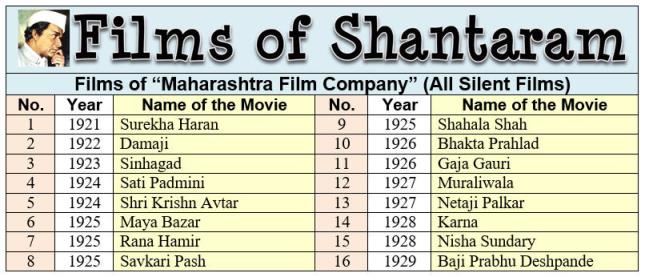 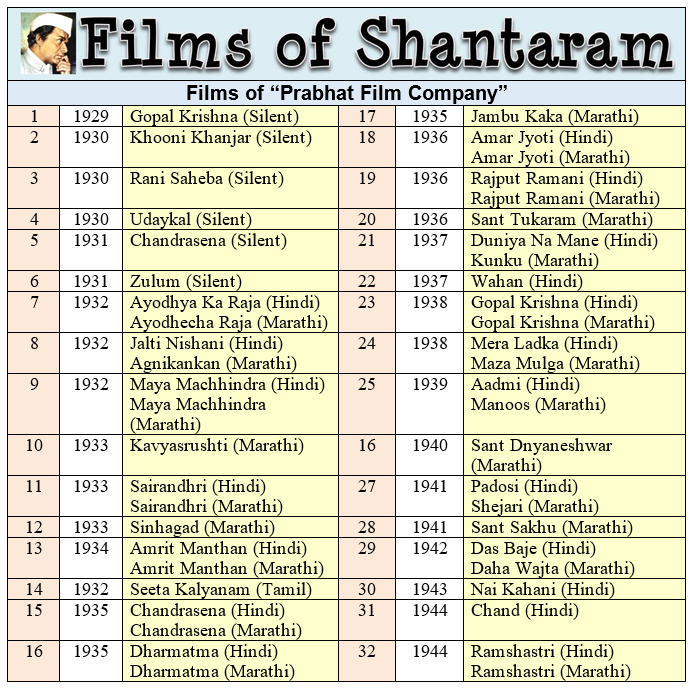 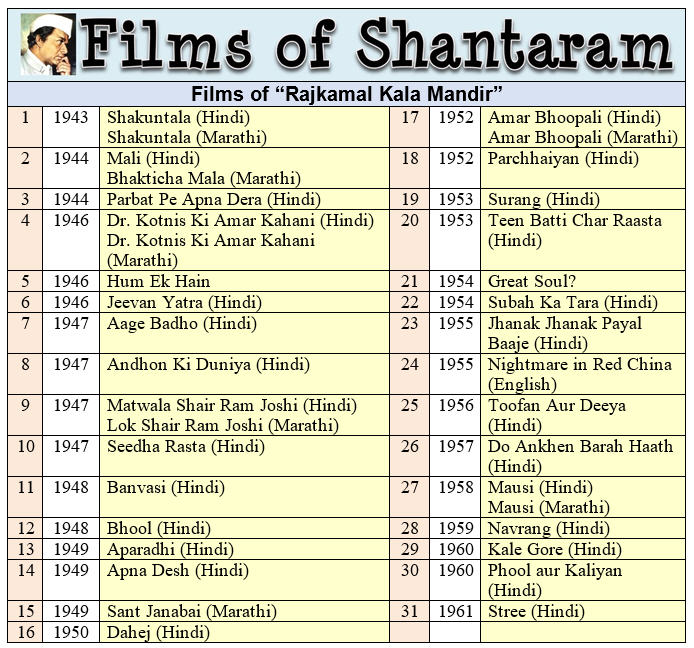 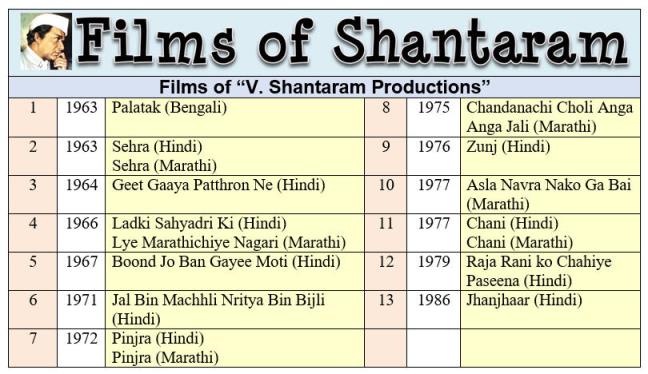
|
  |
Replies
| swarapriya |
 Apr 14 2019, 06:10 PM Apr 14 2019, 06:10 PM
Post
#2
|
|
Dedicated Member  Group: Angels Posts: 15469 Joined: 8-January 08 Member No.: 36307 |
Amrit Mandhan (1934 - Hindi & Marathi)
This film was directed by Shantaram. It was a bilingual shot both in Hindi and Marathi simultaneously. All actors in both films were the same except for one. Keshavrao Date played the part of Rajguru in the Marathi version. In Hindi, it was played by Chandra Mohan. After starring in this pivotal role, Chandra Mohan went onto become a famous actor. This was the first film produced in the new well equipped studio of Prabhat at Pune. While working with UFA Studios in Germany on now canned color picture “Sairandhri”, Shantaram had an opportunity to observe the new wave of films made by German filmmakers. Impressed, he decided to experiment with light and shade for this film. Huge sets and costumes were erected to help accentuate the seldom seen effects in an Indian film. The film was a story of a reformist king pitted against his fanatical Rajguru. Implicit in the story was raising a voice against religious obscurantism and bigotry. The story also alluded to abolishing the practice of human as well as animal sacrifice offered to any Goddess. Shantaram was the first Indian filmmaker to use a telephoto lens to show the close-ups in this film. Until this movie came along there were no close-up shots in Indian films. In one of the close-up shots, Rajguru’s malicious eye fills the entire screen. It was a shocking sight to the 1930’s viewers. The scene was discussed in press and public for years. The movie had such an impact on the public that it became the first film in Hindi to celebrate a silver jubilee. I am attaching a figure below where Shantaram is shooting a scene for the film. The film was shown at the Venice International Film Festival. Some newspapers in London gave the coverage with the photographs from the film and the studio. For this film both Hindi as well as Marathi versions of video format are available. I was elated that at least I will be at home with the Hindi version, it being a familiar language to me. But alas, audio quality is still as bad and verbiage of the songs was difficult to discern. Fortunately I was able to find better quality audios for some of the Hindi songs that I am uploading here. There are 16 songs in this film. Shanta Apte dominated the proceedings with six songs. She even sang a ghazal, again first one for any film, “Kamsini”. Incidentally, Vasant Desai Saab sang a song in this film. Here are few words about Shanta Apte (see her attached picture below)… She was born in a Brahmin family and took to singing at a young age. However she had a rough childhood. She grew up under the observation of her older brother who was a violent and bad man. He used to whip her mercilessly with a cane even for small miscues. Her brother forced her to have sexual relations with him. He wanted Apte to have a child by him. But all this made her to be a stronger woman and gave her courage to bear this stigma openly all her life. Her first film was as a child artiste in the 1932 Marathi film “Shyamsunder.” It was the first Marathi film to celebrate silver jubilee. Shantaram took note of her and signed her for a supporting role in in this film. The movie was a huge hit. It was the first Hindi film to celebrate a silver jubilee. Prabhat Studios immediately signed her for a long term contract. She appeared next in “Amar Jyoti (1936)” and “Rajput Ramani (1936).” Both films were also hits. It was the 1937 bilingual “Duniya Na Mane” that brought her fame and catapulted her to be a number one star in Marathi films. In that film she played a woman who was married to a rich widower. Complications arise when she refuses to accept him as her husband. Her brilliant firebrand acting and singing brought her recognition and fame. In real life also she was famous for her firebrand temperament. Here are a couple of instances that illustrate this. “Filmindia” was an influential film magazine that was published by Baburao Patel. Many filmgoers looked for his reviews in that magazine. Positive reviews from him meant the movie will make money. Otherwise it was doomed to failure. Writing a review on Apte Patel wrote a nasty column about her abilities as a singer as well as an actor. Apte showed up in his office the next morning with a whip in her hand. While the entire staff was looking she whipped him. This incident was published by Patel himself in his next issue of the magazine. Another incident was when she had a fight with Prabhat Studios about her contract. She wanted them to free her up from that contract because she was getting innumerable offers with more money. When they refused, she went on a strike protesting them in front of the studio gates. To avoid bad publicity, Prabhat voided her contract. After that she never worked for them. Shanta Apte went onto act in many films. In one film she acted with Prithviraj Kapoor and his son Raj Kapoor. She acted in a couple of films with Noor Jehan when Madamji was still an up and coming star. In one of the films she sang with her. She also sang with Lata Mangeshkar in one film. She wrote her own biography. She died of a heart attack at the young age of 47. She acted in some 30 plus films. In the next post songs from the Hindi film are given first… Attached image(s)   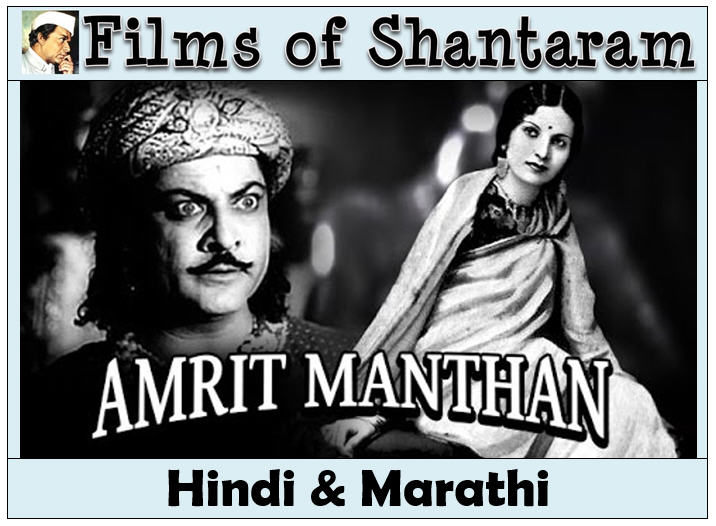
|
Posts in this topic
 swarapriya Visionary - V. Shantaram Jan 6 2019, 09:23 PM
swarapriya Visionary - V. Shantaram Jan 6 2019, 09:23 PM
 swarapriya Surekha Haran (1921) - A Silent Film
This silent ... Jan 6 2019, 09:28 PM
swarapriya Surekha Haran (1921) - A Silent Film
This silent ... Jan 6 2019, 09:28 PM
 Viraj Padhye Nice topic SP. Thanks. Jan 7 2019, 08:19 AM
Viraj Padhye Nice topic SP. Thanks. Jan 7 2019, 08:19 AM

 swarapriya
Nice topic SP. Thanks.
Thank you very much Vira... Jan 7 2019, 10:29 PM
swarapriya
Nice topic SP. Thanks.
Thank you very much Vira... Jan 7 2019, 10:29 PM

 Viraj Padhye
Nice topic SP. Thanks.
Thank you very much Vir... Jan 8 2019, 07:30 AM
Viraj Padhye
Nice topic SP. Thanks.
Thank you very much Vir... Jan 8 2019, 07:30 AM

 swarapriya
[quote name='swarapriya' post='753035' date='Jan ... Jan 8 2019, 08:58 PM
swarapriya
[quote name='swarapriya' post='753035' date='Jan ... Jan 8 2019, 08:58 PM
 swarapriya Damaji (1922) - A Silent Film
This silent Marathi... Jan 8 2019, 09:00 PM
swarapriya Damaji (1922) - A Silent Film
This silent Marathi... Jan 8 2019, 09:00 PM
 swarapriya Sinhagad (1923) - A Silent Film
This silent Marat... Jan 10 2019, 09:42 PM
swarapriya Sinhagad (1923) - A Silent Film
This silent Marat... Jan 10 2019, 09:42 PM
 swarapriya Sati Padmini (1924) - A Silent Film
This silent M... Jan 13 2019, 09:22 PM
swarapriya Sati Padmini (1924) - A Silent Film
This silent M... Jan 13 2019, 09:22 PM
 swarapriya Shri Krishna Avatar (1924) - A Silent Film
This s... Jan 15 2019, 09:56 PM
swarapriya Shri Krishna Avatar (1924) - A Silent Film
This s... Jan 15 2019, 09:56 PM
 swarapriya Maya Bazar (1925) - A Silent Film
This silent Mar... Jan 17 2019, 08:10 PM
swarapriya Maya Bazar (1925) - A Silent Film
This silent Mar... Jan 17 2019, 08:10 PM
 swarapriya Rana Hamir (1925) - A Silent Film
Baburao Painter... Jan 20 2019, 10:48 PM
swarapriya Rana Hamir (1925) - A Silent Film
Baburao Painter... Jan 20 2019, 10:48 PM
 swarapriya Savkari Pash (1925) - A Silent Classic
This silen... Jan 22 2019, 09:17 PM
swarapriya Savkari Pash (1925) - A Silent Classic
This silen... Jan 22 2019, 09:17 PM
 swarapriya Shahala Shah (1925) - A Silent Film
This was the ... Jan 24 2019, 07:45 PM
swarapriya Shahala Shah (1925) - A Silent Film
This was the ... Jan 24 2019, 07:45 PM

 soumik Thanks Swarapriya for starting this thread....
1.... Jan 26 2019, 11:50 PM
soumik Thanks Swarapriya for starting this thread....
1.... Jan 26 2019, 11:50 PM

 swarapriya
Thanks Swarapriya for starting this thread....
1... Jan 27 2019, 10:04 PM
swarapriya
Thanks Swarapriya for starting this thread....
1... Jan 27 2019, 10:04 PM

 soumik Dear Swarapriya....
You got me wrong. I was askin... Jan 28 2019, 09:24 PM
soumik Dear Swarapriya....
You got me wrong. I was askin... Jan 28 2019, 09:24 PM

 swarapriya
Dear Swarapriya....
You got me wrong. I was aski... Jan 29 2019, 08:16 PM
swarapriya
Dear Swarapriya....
You got me wrong. I was aski... Jan 29 2019, 08:16 PM
 swarapriya Bhakt Prahlad (1926) - A Silent Film
This silent ... Jan 27 2019, 10:07 PM
swarapriya Bhakt Prahlad (1926) - A Silent Film
This silent ... Jan 27 2019, 10:07 PM
 swarapriya Gaja Gauri (1926) - A Silent Film
This silent Mar... Jan 29 2019, 08:18 PM
swarapriya Gaja Gauri (1926) - A Silent Film
This silent Mar... Jan 29 2019, 08:18 PM
 swarapriya Muraliwala (1927) - A Silent Film
This silent Mar... Jan 31 2019, 09:44 PM
swarapriya Muraliwala (1927) - A Silent Film
This silent Mar... Jan 31 2019, 09:44 PM
 swarapriya Netaji Palkar (1927) - A Silent Movie
Netaji Palk... Feb 3 2019, 08:00 PM
swarapriya Netaji Palkar (1927) - A Silent Movie
Netaji Palk... Feb 3 2019, 08:00 PM
 swarapriya Karna (1928) - A Silent Film
This silent Marathi ... Feb 5 2019, 09:37 PM
swarapriya Karna (1928) - A Silent Film
This silent Marathi ... Feb 5 2019, 09:37 PM
 swarapriya Nisha Sundary (1928) - A Silent Film
This silent ... Feb 7 2019, 06:27 PM
swarapriya Nisha Sundary (1928) - A Silent Film
This silent ... Feb 7 2019, 06:27 PM
 swarapriya Baji Prabhu Deshpande (1929) - A Silent Film
This... Feb 10 2019, 10:20 PM
swarapriya Baji Prabhu Deshpande (1929) - A Silent Film
This... Feb 10 2019, 10:20 PM
 swarapriya Gopal Krishna (1929) - A Silent Film
Shantaram al... Feb 12 2019, 10:33 PM
swarapriya Gopal Krishna (1929) - A Silent Film
Shantaram al... Feb 12 2019, 10:33 PM
 swarapriya Khooni Khanjar (1930) - A Silent Film
This silent... Feb 14 2019, 10:18 PM
swarapriya Khooni Khanjar (1930) - A Silent Film
This silent... Feb 14 2019, 10:18 PM
 swarapriya Rani Saheba (1930) - A Silent Film
This silent Ma... Feb 17 2019, 10:55 PM
swarapriya Rani Saheba (1930) - A Silent Film
This silent Ma... Feb 17 2019, 10:55 PM
 swarapriya Udaykal (1930) - A Silent Film
This silent Marath... Feb 19 2019, 07:38 PM
swarapriya Udaykal (1930) - A Silent Film
This silent Marath... Feb 19 2019, 07:38 PM
 swarapriya Chandrasena (1931) - A Silent Film
This was a sil... Feb 21 2019, 09:31 PM
swarapriya Chandrasena (1931) - A Silent Film
This was a sil... Feb 21 2019, 09:31 PM
 swarapriya Zulum (1931) - A Silent Film
This was the last si... Feb 24 2019, 09:30 PM
swarapriya Zulum (1931) - A Silent Film
This was the last si... Feb 24 2019, 09:30 PM
 swarapriya Ayodhya Ka Raja (1932-Hindi) & Ayodhyecha Raja... Mar 3 2019, 07:32 PM
swarapriya Ayodhya Ka Raja (1932-Hindi) & Ayodhyecha Raja... Mar 3 2019, 07:32 PM
 swarapriya Ayodhya Ka Raja (1932) - Hindi
Neither the movie ... Mar 3 2019, 07:34 PM
swarapriya Ayodhya Ka Raja (1932) - Hindi
Neither the movie ... Mar 3 2019, 07:34 PM
 swarapriya Ayodhyecha Raja (1932) - Marathi
I am uploading a... Mar 3 2019, 07:45 PM
swarapriya Ayodhyecha Raja (1932) - Marathi
I am uploading a... Mar 3 2019, 07:45 PM
 swarapriya Concluding Songs from "Ayodhyecha Raja (1932)... Mar 3 2019, 07:49 PM
swarapriya Concluding Songs from "Ayodhyecha Raja (1932)... Mar 3 2019, 07:49 PM
 swarapriya Jalti Nishani (1932 - Hindi) & Agnikankan (193... Mar 10 2019, 06:12 PM
swarapriya Jalti Nishani (1932 - Hindi) & Agnikankan (193... Mar 10 2019, 06:12 PM
 swarapriya Jalti Nishani (1932 - Hindi)
Neither the movie ve... Mar 10 2019, 06:15 PM
swarapriya Jalti Nishani (1932 - Hindi)
Neither the movie ve... Mar 10 2019, 06:15 PM
 swarapriya Agnikankan (1932 - Marathi)
I am uploading all so... Mar 10 2019, 06:20 PM
swarapriya Agnikankan (1932 - Marathi)
I am uploading all so... Mar 10 2019, 06:20 PM
 swarapriya Concluding Songs from "Agnikankan (1932 - Mar... Mar 10 2019, 06:25 PM
swarapriya Concluding Songs from "Agnikankan (1932 - Mar... Mar 10 2019, 06:25 PM
 Nandu I had seen a few films on Door Darshan earlier. Gr... Mar 11 2019, 10:00 PM
Nandu I had seen a few films on Door Darshan earlier. Gr... Mar 11 2019, 10:00 PM

 swarapriya
I had seen a few films on Door Darshan earlier. G... Mar 13 2019, 06:15 PM
swarapriya
I had seen a few films on Door Darshan earlier. G... Mar 13 2019, 06:15 PM
 swarapriya Maya Machhindra (1932 - Hindi & Marathi)
This... Mar 17 2019, 06:30 PM
swarapriya Maya Machhindra (1932 - Hindi & Marathi)
This... Mar 17 2019, 06:30 PM
 swarapriya Maya Machhindra (1932 - Hindi)
The Hindi version ... Mar 17 2019, 06:37 PM
swarapriya Maya Machhindra (1932 - Hindi)
The Hindi version ... Mar 17 2019, 06:37 PM
 swarapriya Maya Machhindra (1932 - Marathi)
I am uploading a... Mar 17 2019, 06:43 PM
swarapriya Maya Machhindra (1932 - Marathi)
I am uploading a... Mar 17 2019, 06:43 PM
 swarapriya Continuing Songs from "Maya Machhindra (1932 ... Mar 17 2019, 06:48 PM
swarapriya Continuing Songs from "Maya Machhindra (1932 ... Mar 17 2019, 06:48 PM
 swarapriya Concluding Songs from "Maya Machhindra (1932 ... Mar 17 2019, 06:53 PM
swarapriya Concluding Songs from "Maya Machhindra (1932 ... Mar 17 2019, 06:53 PM
 swarapriya Kavyasrushti (1933) - Marathi
This was a short Ma... Mar 24 2019, 07:37 PM
swarapriya Kavyasrushti (1933) - Marathi
This was a short Ma... Mar 24 2019, 07:37 PM
 swarapriya Sairandhri (1933 - Hindi & Marathi)
This film... Mar 31 2019, 07:10 PM
swarapriya Sairandhri (1933 - Hindi & Marathi)
This film... Mar 31 2019, 07:10 PM
 swarapriya Sairandhri (1933 - Hindi)
Neither video nor songs... Mar 31 2019, 07:16 PM
swarapriya Sairandhri (1933 - Hindi)
Neither video nor songs... Mar 31 2019, 07:16 PM
 swarapriya Sairandhri (1933 - Marathi)
I have no information... Mar 31 2019, 07:18 PM
swarapriya Sairandhri (1933 - Marathi)
I have no information... Mar 31 2019, 07:18 PM
 swarapriya Sinhgad (1933 - Marathi)
This film was edited and... Apr 7 2019, 07:57 PM
swarapriya Sinhgad (1933 - Marathi)
This film was edited and... Apr 7 2019, 07:57 PM
 swarapriya Concluding Songs from "Sinhgad (1933 - Marath... Apr 7 2019, 08:01 PM
swarapriya Concluding Songs from "Sinhgad (1933 - Marath... Apr 7 2019, 08:01 PM
 swarapriya Amrit Manthan (1934 - Hindi)
I am uploading all s... Apr 14 2019, 06:17 PM
swarapriya Amrit Manthan (1934 - Hindi)
I am uploading all s... Apr 14 2019, 06:17 PM
 swarapriya Continuing Songs from "Amrit Manthan (1934 - ... Apr 14 2019, 06:20 PM
swarapriya Continuing Songs from "Amrit Manthan (1934 - ... Apr 14 2019, 06:20 PM
 swarapriya Concluding Songs from "Amrit Manthan (1934 - ... Apr 14 2019, 06:24 PM
swarapriya Concluding Songs from "Amrit Manthan (1934 - ... Apr 14 2019, 06:24 PM
 swarapriya Amrit Manthan (1934 - Marathi)
This film and its ... Apr 14 2019, 06:28 PM
swarapriya Amrit Manthan (1934 - Marathi)
This film and its ... Apr 14 2019, 06:28 PM
 swarapriya Continuing Songs from "Amrit Manthan (1934 - ... Apr 14 2019, 06:32 PM
swarapriya Continuing Songs from "Amrit Manthan (1934 - ... Apr 14 2019, 06:32 PM
 swarapriya Concluding Songs from "Amrit Manthan (1934 - ... Apr 14 2019, 06:35 PM
swarapriya Concluding Songs from "Amrit Manthan (1934 - ... Apr 14 2019, 06:35 PM
 swarapriya Seetha Kalyanam (1934 - Tamil)
This was the only ... Apr 21 2019, 08:03 PM
swarapriya Seetha Kalyanam (1934 - Tamil)
This was the only ... Apr 21 2019, 08:03 PM
 swarapriya Chandrasena (1935 - Hindi & Marathi)
This fil... Apr 28 2019, 06:14 PM
swarapriya Chandrasena (1935 - Hindi & Marathi)
This fil... Apr 28 2019, 06:14 PM
 swarapriya Chandrasena (1935 - Hindi)
Unfortunately, I do no... Apr 28 2019, 06:18 PM
swarapriya Chandrasena (1935 - Hindi)
Unfortunately, I do no... Apr 28 2019, 06:18 PM
 swarapriya Chandrasena (1935 - Marathi)
I am uploading songs... Apr 28 2019, 06:23 PM
swarapriya Chandrasena (1935 - Marathi)
I am uploading songs... Apr 28 2019, 06:23 PM
 swarapriya Concluding Songs from "Chandrasena (1935 - Ma... Apr 28 2019, 06:27 PM
swarapriya Concluding Songs from "Chandrasena (1935 - Ma... Apr 28 2019, 06:27 PM  |
1 User(s) are reading this topic (1 Guests and 0 Anonymous Users)
0 Members:

|
Lo-Fi Version | Disclaimer | HF Guidelines |  |
Time is now: 19th June 2025 - 10:48 PM |
Invision Power Board
v2.1.7 © 2025 IPS, Inc.
Licensed to: Hamaraforums.com








